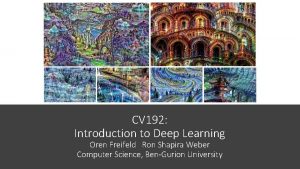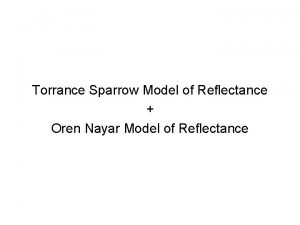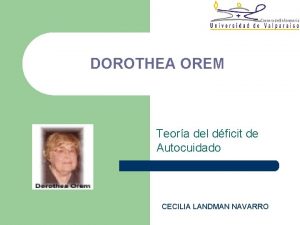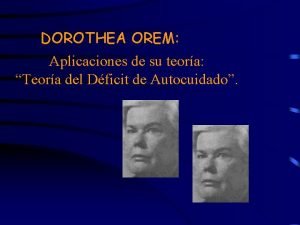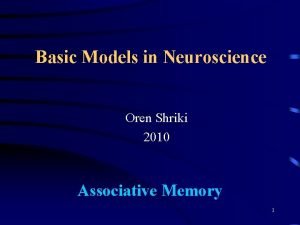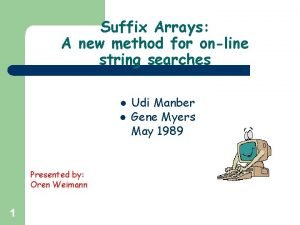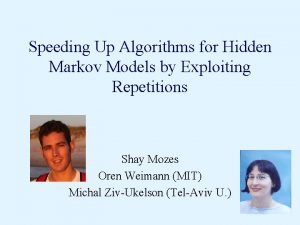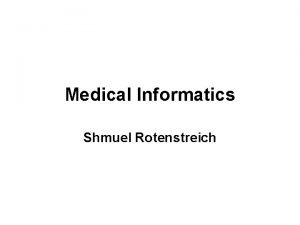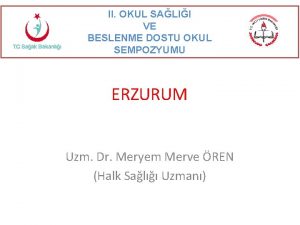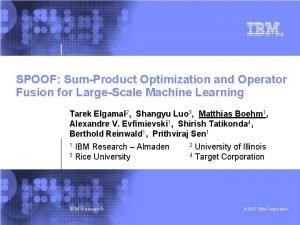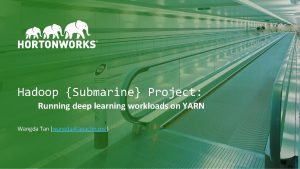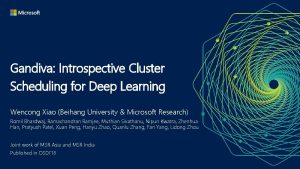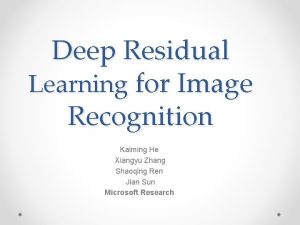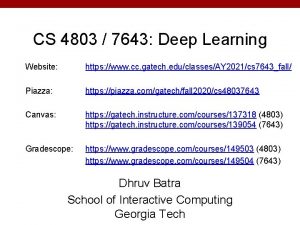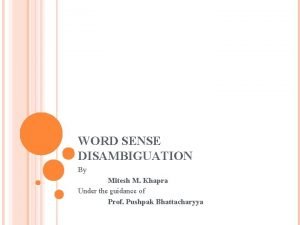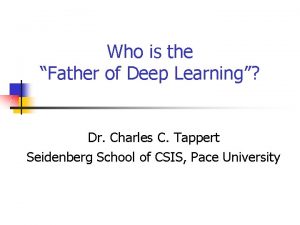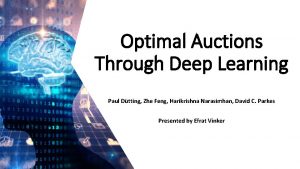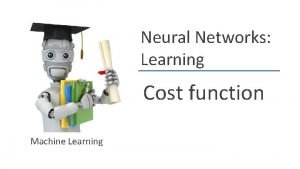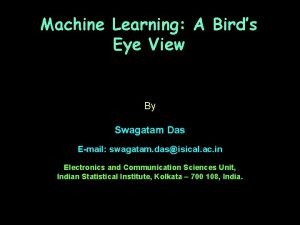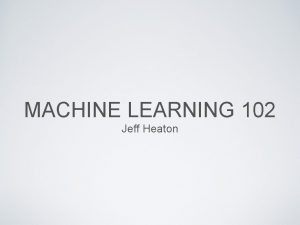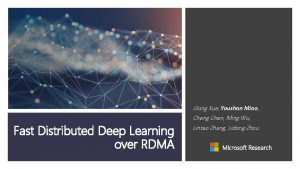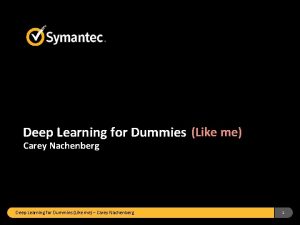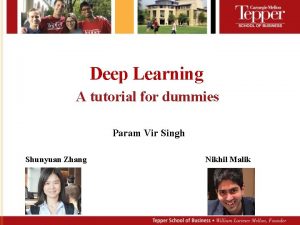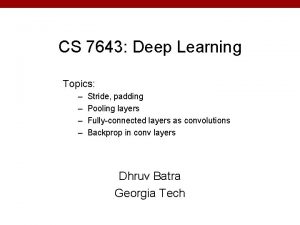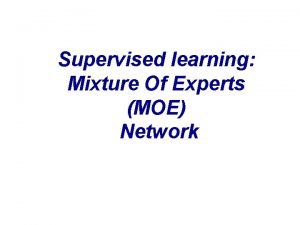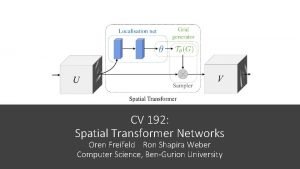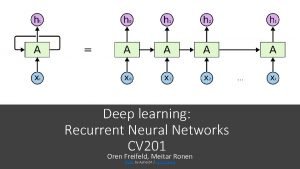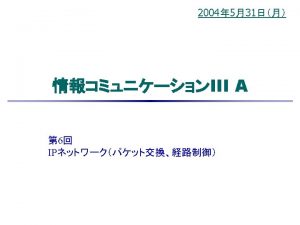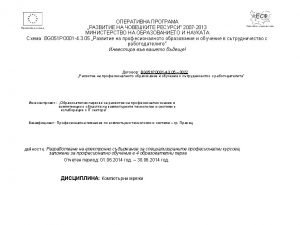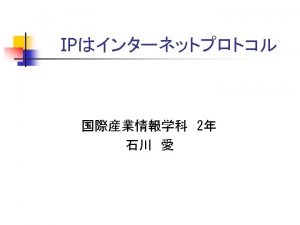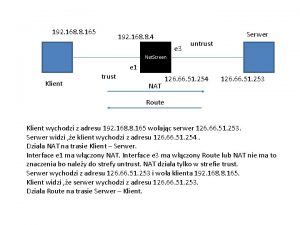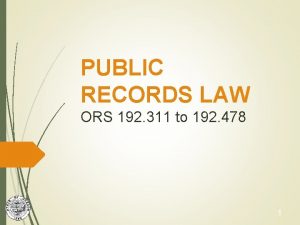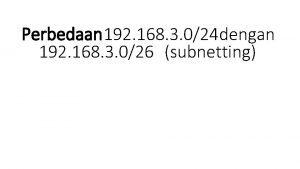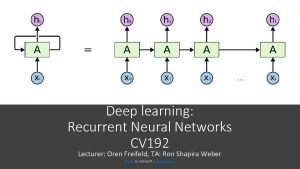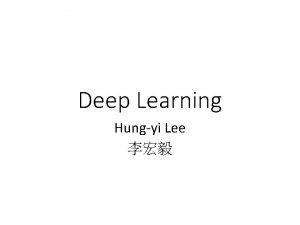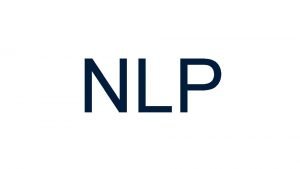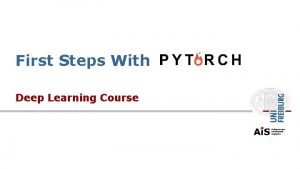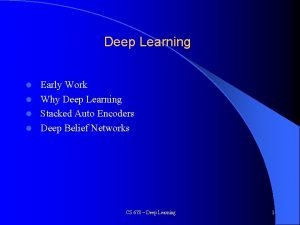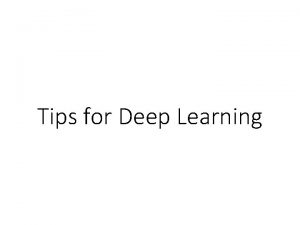CV 192 Introduction to Deep Learning Oren Freifeld









































- Slides: 41

CV 192: Introduction to Deep Learning Oren Freifeld Ron Shapira Weber Computer Science, Ben-Gurion University

Contents • Introduction – What is Deep Learning? • Linear Binary Perceptron • Multi-Layer Perceptron [Figure from previous slide taken from https: //ai. googleblog. com/2015/06/inceptionism-going-deeper-into-neural. html]

What is Deep Learning? From perceptron to deep neural networks

Example – Object recognition and localization [Andrej Karpathy Li Fei-Fei, (2015): Deep Visual-Semantic Alignments for Generating Image Descriptions]

Some history – Image. Net challenge • 1. 2 million images in the training set, each labeled with one of 1000 categories • Image classification problem https: //cs. stanford. edu/people/karpathy/cnnembed/

Some history – Image. Net challenge • One of the Top-5 guesses needs to be the correct one. https: //blog. acolyer. org/2016/04/20/imagenet-classification-with-deep-convolutional-neural-networks/

Increasing Depth on Image. Net challenge Trend of increasing depth (Img Credit: Kaiming He)

Image. Net architecture comparison • Amount of operations for a single forward pass vs. top-1 accuracy [Canziani et al. , (2016). An analysis of deep neural network models for practical applications. ]

Supervised Learning • Data: • X – dataset: Images, Videos, Text, etc… • y – labels (cat, dog, platypus) • Image classification example: Probability distribution over classes Classifier (SVM, LDA, Deep neural network etc…) *We’ll also see variants of deep learning algorithms where it isn’t Cat Dog Platypus 0. 2 0. 14 0. 66

Supervised Learning •

Un-supervised Learning • Solve some task given “unlabeled” data. • An example to unsupervised learning algorithm we saw at this course?

Supervised Learning Framework: •

Example: Deep Learning for Image label classification •

When working with images • 0, 0 0, 1 0, 2 1, 0 1, 1 1, 2 2, 0 2, 1 2, 2 0 1 2 3 4 5 6 7 8

. . . Perceptron

Some History • The perceptron algorithm was invented in 1957 at the Cornell Aeronautical Laboratory by Frank Rosenblatt • It is an extension of the perceptron which was first introduced in the 1950 s. • In 1969 a famous book entitled “Perceptrons” by Marvin Minsky and Seymour Papert showed that it was impossible for perceptrons to learn an XOR function without adding an hidden layer. • Hence the term Multilayer perceptron. https: //en. wikipedia. org/wiki/Perceptron

Linear Perceptron – Single Output . . .

Linear Perceptron •

(Vanilla) Binary Perceptron – Single Output . . .

(Sigmoid) Binary Perceptron – Single Output . . .

Binary Perceptron •

(Softmax) Binary Perceptron - Multiple Outputs . . .

Multiclass Binary Perceptron . . .

Multiclass Binary Perceptron . . . Correct class distribution . .

• http: //cs 231 n. github. io/linear-classify/

Multilayer perceptron (MLP)

The XOR (“exclusive OR”) problem • X 1 X 2 Output 0 0 1 1 1 0

The XOR problem [Figure from: Goodfellow, I. , Bengio, Y. , Courville, A. , & Bengio, Y. (2016). Deep learning]

The XOR problem •

The XOR problem • [Example from: Goodfellow, I. , Bengio, Y. , Courville, A. , & Bengio, Y. (2016). Deep learning]

The XOR problem • [Example from: Goodfellow, I. , Bengio, Y. , Courville, A. , & Bengio, Y. (2016). Deep learning]

The XOR problem • [Example from: Goodfellow, I. , Bengio, Y. , Courville, A. , & Bengio, Y. (2016). Deep learning]

The XOR problem • [Example from: Goodfellow, I. , Bengio, Y. , Courville, A. , & Bengio, Y. (2016). Deep learning]

The XOR problem • [Figure from: Goodfellow, I. , Bengio, Y. , Courville, A. , & Bengio, Y. (2016). Deep learning]

The XOR problem [Figure from: Goodfellow, I. , Bengio, Y. , Courville, A. , & Bengio, Y. (2016). Deep learning]

No hidden layers http: //colah. github. io/posts/2014 -03 -NN-Manifolds-Topology/

MLP with one hidden layer http: //colah. github. io/posts/2014 -03 -NN-Manifolds-Topology/

MLP with one hidden layer http: //colah. github. io/posts/2014 -03 -NN-Manifolds-Topology/

MLP with one hidden layer [Lecun, Y. , Bengio, Y. , & Hinton, G. (2015)]

How big should our hidden layer be? https: //cs. stanford. edu/people/karpathy/convnetjs/demo/classify 2 d. html

Summary • Deep learning is a class of supervised learning algorithms. • Linear binary perceptron acts as a linear classifier. • Hidden layers (followed by non-linear activation function) allows for non-linear transformation of the input so that it could be linear separable. • The number of neurons and connections in each layer determine our model capacity.
 Generative adversarial networks
Generative adversarial networks Oren freifeld
Oren freifeld Oren freifeld
Oren freifeld Cmu machine learning
Cmu machine learning Deep learning approach and surface learning approach
Deep learning approach and surface learning approach Deep asleep deep asleep it lies
Deep asleep deep asleep it lies Deep forest: towards an alternative to deep neural networks
Deep forest: towards an alternative to deep neural networks 深哉深哉耶穌的愛
深哉深哉耶穌的愛 Torrance-sparrow model
Torrance-sparrow model Dorothea orem biografía
Dorothea orem biografía Objetivo de dorothea orem
Objetivo de dorothea orem Oren shriki
Oren shriki Sifat tomato asid atau alkali
Sifat tomato asid atau alkali Joel oren
Joel oren Shmuel oren
Shmuel oren Yossi oren
Yossi oren Oren weimann
Oren weimann Oren weimann
Oren weimann Shmuel oren
Shmuel oren Meryem merve ören
Meryem merve ören Cuadro comparativo de e-learning b-learning y m-learning
Cuadro comparativo de e-learning b-learning y m-learning Operator fusion deep learning
Operator fusion deep learning Recurrent neural network andrew ng
Recurrent neural network andrew ng Hortonworks gpu
Hortonworks gpu Gandiva: introspective cluster scheduling for deep learning
Gandiva: introspective cluster scheduling for deep learning Deep residual learning for image recognition
Deep residual learning for image recognition Deep learning speech recognition
Deep learning speech recognition Cs 7643 deep learning
Cs 7643 deep learning Autoencoders
Autoencoders Machine learning
Machine learning Mitesh kapra
Mitesh kapra Frank rosenblatt perceptron
Frank rosenblatt perceptron Regretnet
Regretnet Deep learning competencies 6 c's
Deep learning competencies 6 c's Neural network cost function
Neural network cost function Bird eye view deep learning
Bird eye view deep learning Jeff heaton deep learning
Jeff heaton deep learning Fast distributed deep learning over rdma
Fast distributed deep learning over rdma Deep learning dummies
Deep learning dummies Convolution for dummies
Convolution for dummies Cs 7643 deep learning
Cs 7643 deep learning Moe deep learning
Moe deep learning


